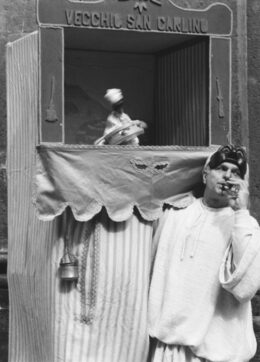Manuscript
20 pages
Author(s)
Le mie prime guarattelle
This text is the first play written by Bruno Leone, during his formation with guarattellaro Nunzio Zampella. Leone wrote it after a trip to Milan where he had seen the glove puppets, swazzle and hand-puppet booth sold by his master to Roberto Leydi, as well as a video recording of the hanging scene performed by Zampella. It was the first time Leone saw a play from the repertoire traditionally played by the Neapolitan guarattellari, about which Zampella had given him very little information. On the train back to Naples, the young guarattellaro wrote this first play in one go, and he performed it at the beginning of his career - most notably as part of his first public performance in Naples on May 1st, 1979. He performed it again forty years later during the opening of his theatre Casa guarattelle “Nunzio Zampella” in Naples. In this play, Leone included the hanging scene as well as some characters and objects that he had seen in Zampella’s puppet shows. This explains its many similarities with the guarattelle’s traditional plays. However, it differs from those thanks to many new elements, including a talking dog, a chick and a roast chicken eaten on stage, and the fact that Pulcinella is a chicken thief. Later, Zampella set up a new performance which added the scenes from the traditional repertoire to the story made up by Leone.
A chicken thief is sentenced to death
Pulcinella appears on stage. He cannot find the audience, as he is facing away from them. After a short skit in which the puppeteer explains to him that the audience is on the other side, Pulcinella introduces the performance and warns the audience: “Si vulit’ capì, v’avita vutà” (If you want to understand, you have to turn around).
The play starts. Pulcinella talks with his stomach, which tells him through gurglings that it is hungry. A hen comes. Pulcinella kills it, plucks it, and eats it. Then, his stomach lets him know that it is content and wants to sleep. Pulcinella is awakened by a dog that came to eat him, because he has eaten the hen of the dog’s owner. Pulcinella knocks the animal out with a stick.
The owner of the dog and the hen, a peasant, comes to get Pulcinella. Pulcinella introduces himself as the owner of the trousers ripped by the dog, and demands to be reimbursed. They settle accounts by beating each other with a stick until Pulcinella kills the peasant. Pulcinella puts the corpse in a casket, and when Death comes to get it and frighten Pulcinella, Pulcinella chases Death away by beating him with the casket.
After several lazzi and puns, a carabinier arrests Pulcinella. We then see Pulcinella’s trial. The judge, also playing the prosecution and the defence lawyer, accuses Pulcinella of having murdered the dog’s owner, the dog, the hen, and, above all, of having eaten the hen. For those crimes, Pulcinella is sentenced to death. A monk hears his confession, and blesses him with a macaronic Latin spell which evokes a series of dishes. Pulcinella has to be hanged, but he cannot put his head in the slipknot. He asks the hangman to show him how to do it, and hangs him in his stead.
